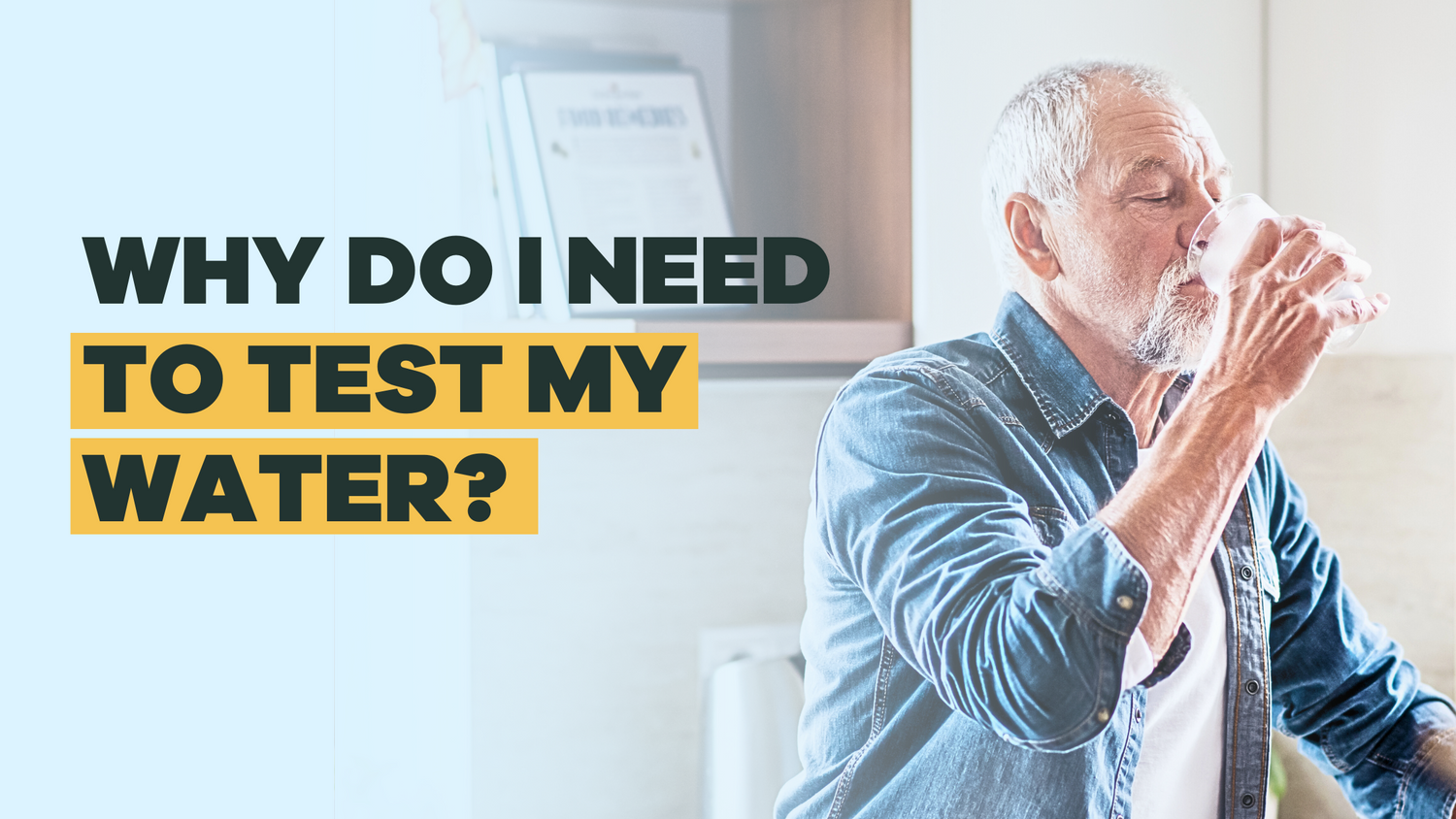
Why People Test Their Water
Our blog is written by real experts— not AI. Each guide is carefully reviewed and updated based on the latest research. Plus, with no affiliate links, you can count on unbiased insights you can trust.
There are countless reasons why people test their drinking water. Whether you want to find the cause of an unusual color or smell, choose an appropriate water treatment system, or you are simply curious about the state of your tap, beginning the process can be daunting.
There are a myriad of testing options across a range of price points. But what’s the right choice? Consider these approaches:
- Changes in Water Color
- Changes in Water Smell
- Before Installing a Treatment System
- Local Water Quality Issues
- Concerns About Water Infrastructure
- Having a Baby
- Curiosity
- What's the Takeaway?
Why Do I Need to Test My Water?
Changes in Water Color
People often start thinking about testing their water when they notice a visible change in water quality, like if your water has turned a strange color. When you’re used to seeing crystal clear water flowing from the faucet, yellow or brown water can certainly be alarming. The good news is that most of the time discolored water does not pose a significant health risk.

For details about common causes of discolored water, what it could mean for your health, and ways to fix it check out our complete guide to discolored water.
There are several different approaches when it comes to finding the source of the problem. There are DIY kits and laboratory testing options. But these two options have very different capacities. While DIY kits do not typically have detection limits as low as laboratory tests, they can usually provide an indicator of presence or absence (which can be a helpful first step) as opposed to an accurate representation of concentrations at low levels.
For yellow or brown water, a good first step is an iron-related bacteria self-test.
However, changes in water color can happen for a variety of other reasons, and laboratory testing may give you a more complete picture. Take a look at our Yellow Tap Water testing package:
Changes in Water Smell
Whether it smells like rotten eggs or chlorine, odd smelling water is another instance where at-home testing may be a good first step.
A few good options to help identify causes of smelly water include:
- For chlorine or bleach-like smell: Chlorine Strips are a great way to get an idea of how much chlorine is in your water. Because laboratory testing for chlorine has specific preservation requirements due to its volatile nature, it can be quite expensive. Testing directly at the tap is a much more affordable route; it will give you a good sense of how much total and free chlorine are in your water.
- For rotten egg smell: Rotten egg smell is most often attributed to sulfur. Tap Score’s Hydrogen Sulfide Bacteria DIY test can help determine if this is the culprit.
However, if you are looking for more thorough answers (as well treatment recommendations), Tap Score home water testing packages will help. Our national team of certified laboratory scientists, engineers, and health experts provide each customer with a personalized Tap Score Water Quality Report.
Before Installing A Water Treatment System
This is an instance where we strongly recommend laboratory testing. Treatment systems come in a variety of shapes, sizes, and prices. Before taking the plunge, you should ask yourself: What problem needs treating?
Because treatment systems can be targeted towards specific contaminants, how will you know the right system to choose if you don’t know what’s actually in your water? Filtration units can set you back thousands of dollars (depending on the unit), so you want to be sure that you’re not paying for something you don’t need.
Our Tap Score testing packages will give you a great sense of your overall water quality, allowing you to make an informed decision. With every water quality report, we provide a personalized and unbiased list of treatment options certified by NSF and WQA.
Local Water Quality Issues
From hurricanes to wildfires to floods, natural disasters can disrupt water quality for months. Immediate danger does not subside once fires are extinguished or flood levels recede. Contaminants can find their way into drinking water supplies, leading to a multitude of potentially serious health and safety risks.
Living near agriculture can impact your water quality as well.
Whether it’s mold, bacteria, or any other contaminant, this is a good time for laboratory testing. The expertise and quality control of laboratory settings ensure your family is receiving highest analytical standards.
Concerns About Infrastructure
It’s no secret that American infrastructure is failing. In fact, the 2021 Infrastructure Report Card by the American Society of Civil Engineers (ASCE) granted U.S water infrastructure a measly “C-” (on an A through F scale). This comprehensive assessment of the nation’s 16 major infrastructure categories evaluates their current state and indicates that the U.S. must invest trillions of dollars in overall infrastructure repairs and improvements to reach acceptable standards. Unfortunately, there is no timetable for if this will happen.
Additionally, if you live in a house built prior to 1986, laboratory testing is a wise investment. Lead was legal in many fixtures and pipes even after 1986 (although the concentrations are lower), and water quality could allow lead to leach into your drinking water. We recommend our Essential City Water test if you live in an older home or you are served by old infrastructure.
Having a Baby
Having a baby is an exciting time, but it brings with it a whole new set of safety concerns. Young children are considered the most vulnerable population group. Children typically drink more water per pound of body weight than adults. This leads greater exposure and subsequently, greater risk. Because their bodies are still developing, toxic chemicals cause more harm to growing tissue.
A common concern for parents with a new baby is too much nitrate, which can lead to methemoglobinemia (also known as blue baby syndrome). If you have young children in your home, laboratory testing is a sure-fire way to know if they are at risk.
Is Tap Water Safe for My Baby?
Curiosity
With knowledge comes power—the power to make informed decisions and to help keep you safe. Laboratory testing is a great way to get a sense of your water’s overall chemistry. Many contaminants—such as lead and arsenic—may be lurking in your water that you can’t smell, taste or see. Home DIY kits and home test trips fall short. Our water testing packages can test for hundreds of contaminants that you didn’t even know were putting you at risk!

Beware of the Free Lab Water Test!
If you are interested in water testing, we can’t emphasize enough: If someone is offering you a free water test, be very suspicious, as it is highly likely that these are the same people trying to sell expensive (and perhaps unnecessary) water treatment products or bottled water subscriptions. Remember the adage, “if it seems too good to be true, it probably is.”
When Can You Trust Water Filter Reviews? A Guide to Red Flags
What's the Takeaway?
There are many reasons to test your water. Below are some of the most common.
- Changes in Water Color: Discolored water is usually not a significant health risk, but it's important to identify the common causes and find ways to fix it.
- Changes in Water Smell: If your water has an unusual smell, at-home testing can be a good starting point. Chlorine strips can help determine chlorine levels, while a hydrogen sulfide bacteria DIY test can identify the presence of sulfur-related smells.
- Before Installing a Water Treatment System: Knowing the contaminants present in your water will help you choose the appropriate system to address the specific problem.
- Local Water Quality Issues: Natural disasters like hurricanes, wildfires, and floods can disrupt water quality, posing health and safety risks.
- Concerns About Infrastructure: Aging infrastructure and the presence of lead in fixtures and pipes can affect water quality. Especially houses built prior to 1986 should test.
- Having a Baby: Testing water for nitrate levels is essential for households with young children to prevent the risk of methemoglobinemia.
- Curiosity: Laboratory testing detects contaminants that may be undetectable by DIY kits.










